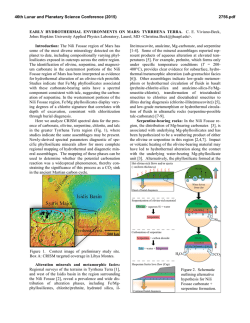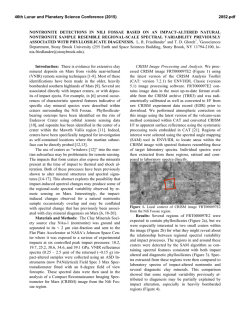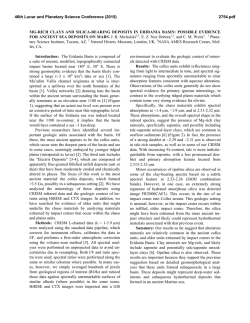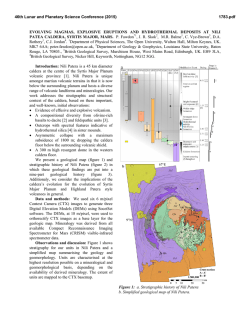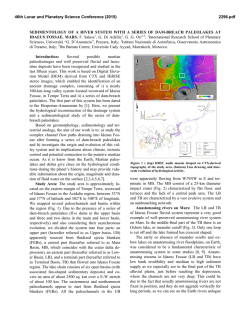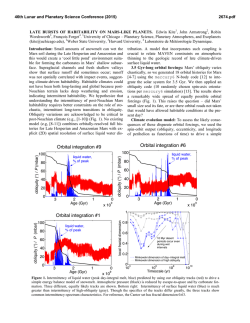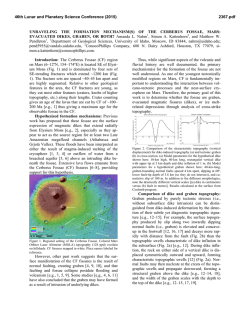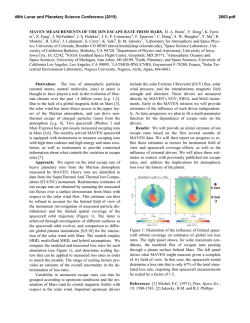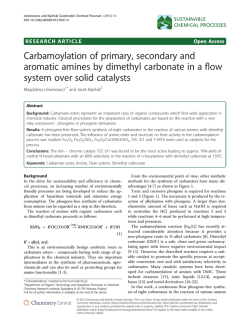
Spectral Analysis of Carbonate Deposits at Nili - USRA
46th Lunar and Planetary Science Conference (2015) 2701.pdf SPECTRAL ANALYSIS OF CARBONATE DEPOSITS AT NILI FOSSAE, MARS A. J. Brown1, J.L. Bishop1 and C. Viviano-Beck2, 1SETI Institute, 189 N. Bernardo Ave, Mountain View, CA 94043 [email protected], 2Applied Physics Laboratory, Johns Hopkins University, Laurel, MD 20723. Introduction: Given the unique role of carbonate in preservation of biogenic signatures on Earth, understanding the nature and disposition of carbonate deposits on Mars is key to unlocking the astrobiological history and the nature of past aqueous environments on the Red planet [1]. CRISM has detected Mg-carbonate at Nili Fossae [2] and small amounts of carbonate have also been discovered by Spirit and CRISM at Gusev Crater [3,4]. The carbonates have been found in combination with talc and saponite [5, 6]. Here we begin a program of numerical discovery to learn more about the signatures of carbonate spectra located in Nili Fossae in the hope of better characterizing their formation processes. Methods: Brown et al. [6] carried out an analysis of the 2.3 and 2.5 micron bands of carbonate for one CRISM image (FRT40FF). Here we extend that analysis by applying a similar technique to other carbonate bearing images. We report the findings for CRISM FRT image 9D44 (Figure 1) here. For each pixel in the image, the steps of the analy sis are as follows: 1.) We first use DISORT to carry out an inversion procedure and create a model surface albedo [7]. 2.) Second, using the spectrum from the DISORT based inversion, we determine the asymmetry of the 2.3 and 2.5 bands using the formula suggested in [6]: Results: Figure 2 shows an example of the results we have obtained so far. The test image is FRT 9D44, which is taken from the southern reaches of Nili Fossae, near 20°N, 73°E. Figure 1 – CRISM FRT 9D44 showing the edge of an escarpment of Nili Fossae to the right and Syrtis Major plains to the west. Image is approximately 10km across. Figure 2 – (top) BDCARB index for CRISM FRT 9D44 (bottom) 2.3 micron centroid image. Figure 2 (top) shows the BDCARB index, which shows the strength of the 2.3 micron band, which here is most likely due to carbonate. Figure 2 (bottom) shows the centroid of the asymmetric 2.3 micron band, showing some variation, possibly due to Fe-Mg-OH substitution. The regions in white show a large 2.3 micron band. Note the sharp contact on the west is due to he edge of the escarpment and the strongest carbonate features occur at the top level exposure of the Fossae. Figure 3 shows a DISORT corrected surface albedo of one of the hotspot locations of the BDCARB index, at x=296,y=170. Some residual atmospheric signatures are still visible at 2 microns, and the spectral range from 2.65-2.8 microns has been omitted due to CRISM irregularities in that region. Relatively strong 2.3 and 2.5 bands are readily visible. A secondary 2.4 micron band is present, likely due to the presence of talc [5]. Figure 3 – DISORT corrected spectrum from x=296, y=170 (original CRISM image coords). 46th Lunar and Planetary Science Conference (2015) 2701.pdf Fi Figure 5. Geological framework at Nili Fossae gure 4. Nili Fossae mineral occurrence map from [5] as modified from [7]. Location of 9D44 in Figures 1 and 2 is shown by red triangle. Association of Talc and carbonate: Two recent studies have uncovered corroborating spectral evidence for talc in Nili Fossae on Mars using the CRISM spectrometer on Mars Reconnaissance Orbiter. Inspired by fieldwork in the Pilbara region of Western Australia, Brown et al. [4] suggested talc was present in some locations where saponite had been identified in the earlier study by Ehlmann et al. [8]. Viviano et al. [6] then found an identifying marker for talc vs. saponite which confirmed the presence of talc and mapped the loca tions of the mineral signature using this spectral feature. The results of her mapping are shown in Figure 4. Talc, Mg3Si2O5(OH)4 is an important mineral for identifying processes of hydrothermal alteration in ultramafic sequences in the Archean greenstone belts on Earth [9], and has been suggested to be evidence for high ocean temperatures in the past [10]. As an alter ation mineral of Mg-olivine it is likely to play the same role on Mars [11]. Potential Terrestrial analogs: Serpentine and magnetite are by-products of the reaction from Mgolivine to talc. Talc has also been found in association with actinolite in hydrothermal vent systems such as that at the Lost City hydrothermal field [12]. In the Pilbara craton in Western Australia, talc has been found replacing Mg-olivine in komatiite cumulate zones in ultramafic sections of the Dresser Formation [9]. New Martian alteration class. McSween et al. [13] followed up the talc discovery recognizing talccarbonate as forming one of six alteration classes in evidence at Nili Fossae. Figure 5 shows a geological timeline for the Nili Fossae region based on recent global scale maps of Mars [14]. It is the aim of this study to examine formation hypotheses associated with the Syrtis Major lava flows to the potential primordial Martian crust that might be accessible at Nili Fossae. Astrobiological Implications: Early Mars and Earth had hotter mantles in their early stages of formation [15], following overturn of their respective magma oceans, when life began on Earth and may have started on Mars [16]. The presence of talc (particularly in combination with carbonate) is consistent with hydrothermal alteration of ultramafic rocks in an ocean-floor setting [10], and may lead the way to astrobiologically rich regions on Mars. As discussed by Mustard et al. [17], Nili Fossae contains ancient crust on Mars that includes pre-Isidis basement rocks and post-Isidis brecciated materials. This complex history will be challenging to interpret, but interpret it we must, because it may constitute a geological time capsule within which we can examine our own origins. Acknowledgements: This work is partly funded by the NASA Astrobiology Institute, through the SETI Institute team led by PI Nathalie Cabrol. References: [1] Niles, P.B. et al. (2013) SSR 301328 [2] Ehlmann B. et al. (2008) Science 322 1828-32 [3] Morris et al. (2010) Science science.1189667 [4] Carter and Poulet (2012) Icarus [5] Brown, A. J., et al. (2010) EPSL 297 174–82 [6] Viviano, C. E., et al. (2013) JGR 118: 1858–72 [7] Wiseman, S.M. et al. (2014) Icarus [8] Ehlmann, B. L. et al. (2009) JGR 114 10: doi://10.1029/2009JE003339 [9] Brown, A.J. et al. (2005) AJES 52 353–364 [10] Costa, U. R., (1980) Chemical Geology 30, no. 4: 341–49. [11] Mustard, J.F. (1991) 949. Houston, Tx: LPI [12] Kelley, D.S., et al.(2005) Science 307, no. 5714 : 1428–34. [13] McSween, H.Y.. et al. (2014) MAPS (2014) 1–14 [14] Tanaka et al (2014) USGS Map of Mars [15] ElkinsTanton, L. T., et al. (2005) JGR 110, no. E12 (2005): E12S01. doi:10.1029/2005JE002480. [16] Russell, M., et al. (2014) Astrobiology: 308–43. [17] Mustard, J. F., et al. (2009) JGR 114: doi:/10.1029/2009JE003349.
© Copyright 2025
